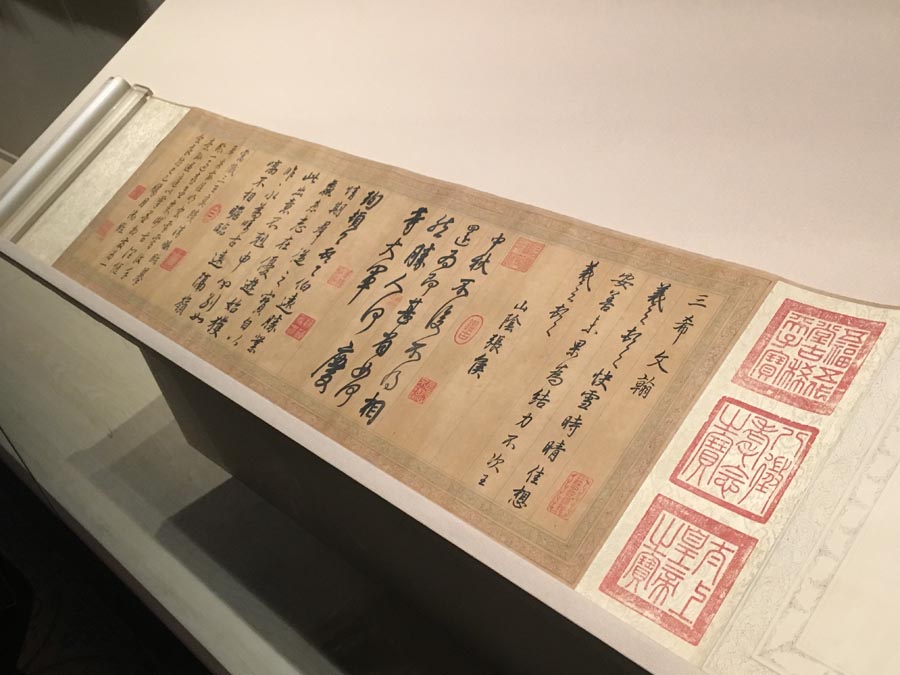


Qianlong's handwritten copy of three calligraphy masterpieces from the Eastern Jin Dynasty that he had collected. [PHOTO BY WANG KAIHAO/CHINA DAILY]
The "three rarities", all dating back to the Eastern Jin Dynasty (317-420), are fine art icon Wang Xizhi's Clearing After Snowfall, his son Wang Xianzhi's Mid-Autumn Festival and Wang Xun's Letter to Boyuan. Due to their age and the fragility of paper-based artworks, the trio are generally considered among the most precious remnants in the history of Chinese calligraphy.
One of the works on display, Dong Bangda's landscape Memories of the Hall of the Three Rarities, places Wang Xizhi at the center of the image as if to depict the emperor reimagining his idol, according to a long paragraph of emotional comments Qianlong left on one corner of the painting.
Zhao says the emperor created dozens of reproductions of the "three rarities", according to records in the Stone Moat, and one of these works appears in the exhibition.
"Through this, Qianlong is showing his devotion to the origins of traditional Chinese calligraphy," she says.
Following his edict, Qianlong's courtiers produced Model Books of Calligraphy From the Hall of Three Rarities, which features more than 300 reproductions of the most important works of calligraphy from Chinese history.
"This represents a major contribution to the inheritance of ancient Chinese art," Zhao says.
Another highlighted exhibit that comes from Qianlong is his reproduction of the Northern Song Dynasty (960-1127) painting, Elegant Gathering in the Western Garden. The original painting portrays a group of celebrated literati of the time, including Su Shi, Mi Fu, Huang Tingjian and Li Gonglin.
Other signatures on the painting suggest the work was jointly produced by the emperor and several of his courtiers.
Apparently, Qianlong wanted a similarly elegant gathering in the Forbidden City as well.
"The high officials surrounding Qianlong were a group of literati with fine cultural tastes," the curator says. "They shared the emperor's emotions."
In 1743, Qianlong invited the capital's literati to attend the first tea party at the Palace of Double Glory (Chonghua Gong) in the Forbidden City, which became a tradition during his reign.
"The emperor set a theme for each party, and wrote impromptu poems, prompting the guests to follow suit," Zhao says. "This helped to form a closer bond between the ruler and court officials."
Shi Yi Shi Er Tu (The One and Two), another painting on display, is an apparent reflection of the emperor's ideals. The painting depicts Qianlong, dressed in the style of a Han Chinese literati despite being a Manchu, sitting in his study. A portrait of him hangs on the screen behind him.
The scene presents an impromptu question: Which one is Qianlong's true identity? The one on the throne with ultimate power in real life, or the one in the painting who revels in joyful leisure?
 |

 Award-winning photos show poverty reduction achievements in NE China's Jilin province
Award-winning photos show poverty reduction achievements in NE China's Jilin province People dance to greet advent of New Year in Ameiqituo Town, Guizhou
People dance to greet advent of New Year in Ameiqituo Town, Guizhou Fire brigade in Shanghai holds group wedding
Fire brigade in Shanghai holds group wedding Tourists enjoy ice sculptures in Datan Town, north China
Tourists enjoy ice sculptures in Datan Town, north China Sunset scenery of Dayan Pagoda in Xi'an
Sunset scenery of Dayan Pagoda in Xi'an Tourists have fun at scenic spot in Nanlong Town, NW China
Tourists have fun at scenic spot in Nanlong Town, NW China Harbin attracts tourists by making best use of ice in winter
Harbin attracts tourists by making best use of ice in winter In pics: FIS Alpine Ski Women's World Cup Slalom
In pics: FIS Alpine Ski Women's World Cup Slalom Black-necked cranes rest at reservoir in Lhunzhub County, Lhasa
Black-necked cranes rest at reservoir in Lhunzhub County, Lhasa China's FAST telescope will be available to foreign scientists in April
China's FAST telescope will be available to foreign scientists in April